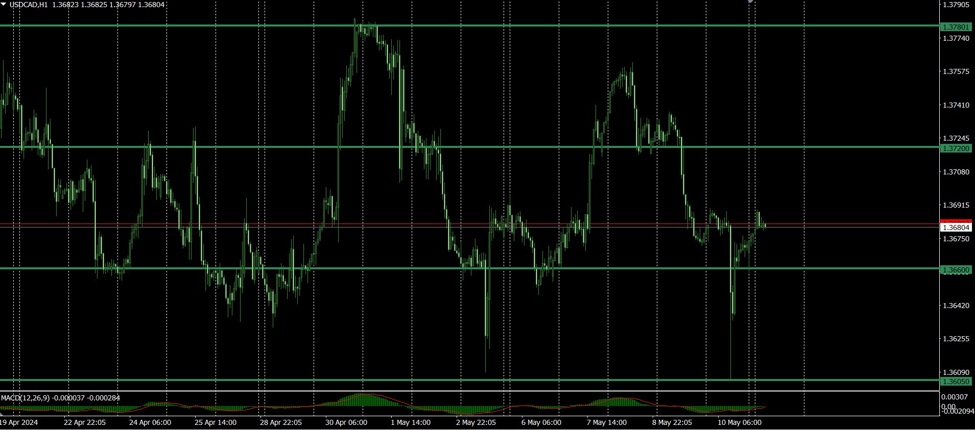The week begins with a relatively quiet start on Monday with a focus on New Zealand’s inflation expectations survey q/q.
On Tuesday, the United Kingdom will see the release of the claimant count change, average earnings index 3m/y and the unemployment rate. Meanwhile, in the United States, market participants will be watching the PPI m/m data.
Wednesday brings the release of the wage price index q/q in Australia, while the U.S. will get the inflation data, which is the most anticipated data print of the week. Additionally, market watchers will receive retail sales data and the Empire State manufacturing index.
Thursday will see Australia’s release of the employment change and unemployment rate. Meanwhile, the U.S. will get the weekly unemployment claims, building permits, Philly Fed manufacturing index, housing starts and industrial production m/m.
Throughout the week, several FOMC members are scheduled to deliver remarks, including Fed Chair Powell, who will speak at the Netherlands’ Foreign Bankers’ Association in Amsterdam, with audience questions expected.
The RBNZ’s expectations survey will likely show an inflation decline, continuing the trend from last quarter and in line with the actual inflation drop over the last year. However, the expected inflation levels, both short-term and long-term, will remain higher than before the pandemic and they’re dropping at a slower rate than previously anticipated.
As a reminder, the next RBNZ meeting is next week and it’s likely that the Bank will keep its OCR unchanged. There was some softness in the labor market data lately, but inflation surprised to the upside.
In the U.K. the consensus for the claimant count change is to rise by 10.9K compared to the prior 13.9K. The average earnings index 3m/y is likely to drop from 5.6% to 5.3% and the unemployment rate is expected to rise from 4.2% to 4.3%. Traders will monitor this week’s labor market and wages data for signs of inflationary pressures.
At the last meeting, the BoE stressed that the labor market is still tight from a historical point of view but there are signs some cooling is underway. Wages have started to soften, which is a good sign and this trend is likely to continue. The BoE will want to see continued decreases in prices and the pace of wage growth before it starts lowering interest rates. Analysts’ opinions are split regarding the timing of the first rate cut with some of them pointing to August and others to June.
In Australia the consensus for the wage price index q/q is 1.0% from prior 0.9% in Q3 2023. However, analysts from ING note that this week’s data could see a slight decline during the first quarter to 0.8% q/q, as the RBA also noted in their recent statement that wage growth had peaked. The annual growth rate is expected to show a rise to 4.3% from 4.2% as growth in Q1 2023 was modest.
U.S. inflation data will be the highlight of this week as everyone wants to see if the recent uptick was temporary or not. The consensus for the core CPI m/m is 0.3% from 0.4% prior; CPI m/m is 0.4% from 0.4% prior and the CPI y/y is expected to drop from 3.5% to 3.4%.
If this week’s data prints below consensus it will likely fuel rate cut expectations. Analysts from ING believe that a 0.2% print or lower will give Fed confidence that the y/y inflation will drop towards its 2% target, but for now that seems unlikely to materialize. However, even if inflation doesn’t drop as fast as previously anticipated, at least it is not increasing back up.
The consensus for the U.S. core retail sales m/m is 0.2% from 1.1% prior and for the retail sales m/m it’s 0.4% (prior 0.7%). The picture is not very optimistic for retail sales compared to March with rising loan delinquencies showing consumers are under stress.
U.S. industrial production also remains under pressure due to difficult credit conditions and high borrowing costs, as well as the overall uncertainty in the economy. The consensus for this week’s data is a growth of 0.2% compared to 0.4% prior.
In Australia the employment change is expected to show a growth of 25.3K from a previous decline of 6.6K, while the unemployment rate is anticipated to increase slightly from 3.8% to 3.9%.
Labor market data in Australia has been hard to predict lately due to high seasonal volatility with the April figures also expected to be impacted by the Easter and school holidays. The unemployment rate increased modestly in March and it’s likely to rise again in April, but remains low compared to historical levels.
The RBA stressed that the labor market remains tight and that easing is only gradual, but there are signs of continued weakening in the near term.
USD/CAD expectations
The better than expected employment report for Canada didn’t support the CAD too much. However, the market now expects the BoC to start cutting interest rates in July (previously in June) as the gains in employment were solid so more caution is needed.
In terms of economic events there will be many data prints this week that could impact both the CAD and the USD. The BoC will monitor housing data to assess the demand as buyers anticipate lower interest rates in the future. The highlight in the U.S. will be the release of inflation data, along with industrial production, PPI and retail sales figures.
On the H1 chart USD/CAD looks good for selling opportunities from a technical perspective. The pair could test the resistance at 1.3720 and if it doesn’t break through it could resume its downtrend and reach the support at 1.3605. On the upside, the next resistance level is at 1.3780.
A risk for this trade is the U.S. inflation data which will strengthen the USD if it prints above expectations.
USDCAD 1 hour chart















